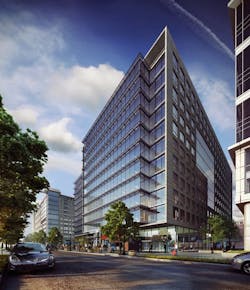Living Building vs. LEED Platinum: Comparing the first costs and savings
In 2011, Skanska completed the West Coast’s first and the world’s fourth certified Living Building in Seattle: The Bertschi School Science Classroom addition. But Living Buildings—which must meet a series of ambitious performance requirements, including net zero energy, waste and water, over a minimum of 12 months of continuous occupancy—are still so rare that many questions remain about how they compare financially to its next closest neighbor, LEED Platinum.
So when the District of Columbia’s Department of Environment was looking to understand the costs and benefits associated with net zero energy, net zero water and Living Buildings, our team was eager to help with this effort of quantifying the rewards of ultra-green buildings.
The District of Columbia’s Department of Environment had two goals: first, to investigate the costs associated with upgrading existing buildings from LEED Platinum to zero energy, zero water and Living Building. And second, to collect data to advise policy makers on deep-green buildings and incentives.
Their findings are published in: Net Zero and Living Building Challenge Financial Study: A Cost Comparison Report for Buildings in the District of Columbia. For the study, Skanska joined the New Buildings Institute (NBI) and the International Living Future Institute (ILFI) to conceptually transform three LEED v3 Platinum-designed buildings in the District to net zero energy, net zero water and Living Buildings. Three reference buildings were chosen to represent three of the most common developments in the District of Columbia: new office construction, new multifamily construction and office renovation.
NBI and ILFI determined the most appropriate energy efficiency and renewable energy strategies for the buildings, while Skanska determined the anticipated differential costs for the various energy strategies employed.
The team applied a set of energy efficiency measures to each building’s envelope, lighting, HVAC, operations, occupancy and direct loads, along with rainwater harvesting techniques in order to achieve reduced energy and water usage before adding photovoltaics and water-reuse strategies.
The costs for getting to net zero are difficult to distinguish from overall project costs. However, our team conducted an analysis to identify costs connected to energy and water conservation, as well as the photovoltaic and water reuse systems necessary for such a project.
SO WHAT'S THE ANSWER?
The initial cost for energy efficiency is approximately 1-12 percent higher, varying by the building type. This rises to 5-19 percent in net-zero energy buildings when considering the added cost of photovoltaic power supply. But the benefits make the added cost worthwhile: the energy efficiency measures alone offer a return on investment of 6-12 percent. After factoring current tax and renewable energy credits into these figures, the return on investment in net zero building is approximately 30 percent.
That is not to say the net-zero goal is appropriate or feasible in every case. When considered in isolation, even ultra-efficient 300,000-sf buildings with today’s onsite renewable energy technology cannot generate as much energy or collect as much water as they consume over the course of a year. In fact, these buildings would require up to seven equivalent rooftop areas to achieve net zero. And achieving net zero is not only a matter of design; it also requires careful attention in such areas as operations and maintenance.
But ultimately, this project yielded valuable results that will inform future design decisions on our journey to Deep Green. The largest benefit: it raises the dialogue over the value of net zero to a new level.
Facility owners now have something tangible to consider when looking at high-performance buildings. We’ve come a long way with Living Buildings, but there is now a true framework to have meaningful conversations shifting from first cost alone to life-cycle value, emboldening market leaders to explore building solutions that push the envelope toward a more sustainable future.
About the Author
Steve Clem is Vice President of Preconstruction with Skanska USA. More posts by Clem.
